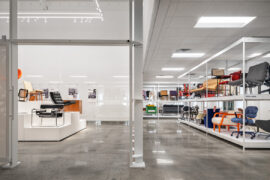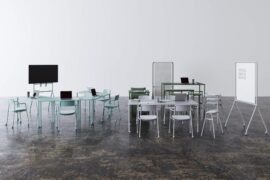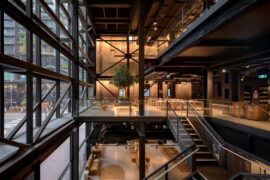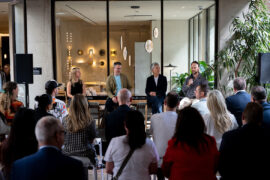In its 2024 Global Workplace Survey Gensler asserts that’s we’re moving beyond the tiring discussions of employee presenteeism, to focus on workplace performance. What is the measure of success for top performers at work? And what are the strategies and solutions to get you there? The findings might surprise you.

December 2nd, 2024
In the course of Lisa Munao’s role as managing director of Gensler Australia, deep conversations with people of all job descriptions have revealed a common ideal among workers, who are seeking out “more fun, more vibrancy where they feel connected and empowered”.
Gensler’s Global Workplace Survey 2024, entitled ‘Moving beyond employee presence to workplace performance’, surveyed more than 16,000 office workers across 15 countries, and 10 industries. Forty-two per cent of respondents stated the top reason for coming into the workplace was to socialise with their colleagues. Similarly, 40 per cent stated their top reason was to work alongside and collaborate with their team.
According to the survey there are strong correlations between high performing workers and the level of social and connective cohesion they experience at work. As the survey lays out, performance at an individual level is measured by employee engagement (that is, how energised and happy they feel when they are working); and team performance is measured by the strength of team relationships (learning from and relying upon other members, open sharing of ideas, and overall team dynamics).
The impetus is on designers, then, to successfully create the conditions within which a person and a team might perform to the highest ability. This brings into focus the importance of spatial effectiveness, measured by Gensler on factors of function, layout, availability, and proximity.
To delve deeper into this concept, we turn to Jonathan Custance, founder and director of furniture company A.Works, whose Agile Wall system redefines flexibility and collaboration to better enable productivity and connection in agile working environments.

Custance, himself a practicing architect with a specialisation in workplace design, saw an opportunity for a reconfigurable partitioning system that could be quickly assembled and disassembled (without tools), and offers functional wall space that could be responsive to change as it happened.
The Agile Wall doesn’t replace the fully fledged boardroom, says Custance, however it does provide structure for meetings within open plan and rapidly adapting office environments. As a working wall which absorbs sound and accommodates AV monitors, power and data, it gives definition to zones and accommodates evolving floor variations.
The concept was first developed for Bank of New Zealand in 2018, before Custance and his team undertook extensive design and manufacturing development to bring the Agile Wall system into line with international sustainability standards. Since then, it has been enthusiastically adopted by the likes of ASB and Westpac in New Zealand.

“These organisations are using the Agile Wall system instead of building walls,” says Custance, who points out that the tax depreciation is significantly higher than hard fit-out, due to it being classified as furniture. The system also uses FSC and PEFC products – locally sourced where possible, along with recycled plastics and metals (the latter powder coated rather than wet sprayed), with low- or zero-VOC certified materials (this includes E0 MDF and Red List Free Certified acoustic panels).
With an emphasis on ‘helping teams thrive’, the system transforms space and interactions through numerous configurations (including Linear, Radial, Room, Drift and Honeycomb), as well as accessories and tools that can be clipped on and off to accommodate pinning, whiteboarding, hanging and storage.
“Whether defining spaces, providing visual and acoustic separation, or creating usable wall space, Agile Wall offers metre by metre adaptability and endless flexibility,” says Custance.

Munao, too, is hearing a growing call for workspaces that are designed “to be ready to adapt”. In life and business, the pace of change is accelerating, with global socio-economic factors creating ripple effects that challenge traditional operations. “Businesses expand and contract due to all those influences, and one of the biggest issues right now is that many organisations aren’t sure of what to do next.”
For example, how much space will they need? What is the ideal mix of spaces and tools for their unique way of working? Importantly, how can their workplace environment stay flexible as their business needs change?
“I think the very clever, innovative solutions are in designing a space with a modular approach, and at the same time achieving a great design aesthetic that meets the expectations and objectives of that particular organisation,” says Munao.

“The quality of design is so important and the aesthetic has to be as equally as important as the functionality of the space.” But more than that, says Munao, “It is imperative to design for resilience. Focus on opportunities to repurpose, recycle and transform existing environments to new. Specify materials and systems of quality for longevity, that are kind to people and the planet.”
Agile Wall is available in Australia through Living Edge.
Living Edge
livingedge.com.au
Gensler
gensler.com
INDESIGN is on instagram
Follow @indesignlive
A searchable and comprehensive guide for specifying leading products and their suppliers
Keep up to date with the latest and greatest from our industry BFF's!

The undeniable thread connecting Herman Miller and Knoll’s design legacies across the decades now finds its profound physical embodiment at MillerKnoll’s new Design Yard Archives.

Welcomed to the Australian design scene in 2024, Kokuyo is set to redefine collaboration, bringing its unique blend of colour and function to individuals and corporations, designed to be used Any Way!

A curated exhibition in Frederiksstaden captures the spirit of Australian design

London-based design duo Raw Edges have joined forces with Established & Sons and Tongue & Groove to introduce Wall to Wall – a hand-stained, “living collection” that transforms parquet flooring into a canvas of colour, pattern, and possibility.

From Valmont to GEYER VALMONT, Marcel Zalloua walks us through some of the milestones of what has been a fruitful, busy career in design.

Tzannes has completed work at The Brewery in Sydney’s Central Park, marking the culmination of an internationally significant adaptive reuse project.
The internet never sleeps! Here's the stuff you might have missed

Director Ian Briggs is one of the longest serving members of the Plus team and – with a milestone rebrand complete and a Sydney event just yesterday – he walks us through the state of play at the practice in 2025.

The CBD and South Melbourne Precinct promises a day of design experiences that balance movement, wellbeing, innovation and hospitality.